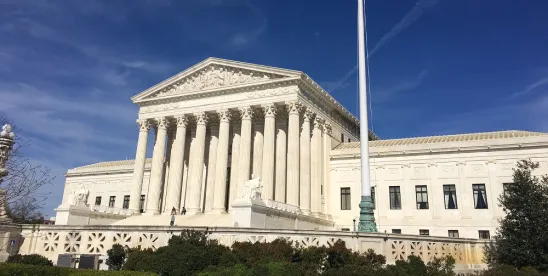At the end of last month, the U.S. Supreme Court heard oral argument in Kisor v. Wilkie, a case in which the question before the Court is whether it should overrule a line of cases instructing courts to defer to an agency’s interpretation of its own regulation, a doctrine sometimes referred to as “Auer deference.” The name derives from Auer v. Robbins, a 1997 U.S. Supreme Court opinion written by Justice Scalia for a unanimous court. In Auer, the Court ruled that the Department of Labor’s interpretation of its own regulation controlled unless it was plainly erroneous or inconsistent with the regulation.
The case that is now before the Court was brought by James Kisor, a Vietnam War veteran who filed for benefits for post-traumatic-stress disorder. In 2006, the Department of Veterans Affairs agreed with Mr. Kisor that he suffered from PTSD, but refused to give him benefits dating back to 1983 as he had sought. In denying his claim, the VA relied on its interpretation of the term “relevant” in a VA regulation that addresses the VA’s reconsideration of a claim. The regulation provides for reconsideration “if VA receives or associates with the claims file relevant official service department records that existed and had not been associated with the claims file when the VA first decided the claim.” (emphasis added). The VA concluded that certain documents offered by Mr. Kisor in support of his claim were not “relevant” because they were not “outcome determinative.” The VA’s decision was affirmed by the Court of Appeals for Veterans Claims. Mr. Kisor then appealed to U.S. Court of Appeals for the Federal Circuit, which deferred to the VA’s interpretation in affirming the lower court’s decision.
In his main brief, Mr. Kisor argues that Auer deference is inconsistent with the federal Administrative Procedure Act because it circumvents the APA’s notice-and-comment rulemaking requirements. He describes Auer deference as “fundamentally at war with basic principles of predictability and public notice at the heart of the APA.” Mr. Kisor also contends that Auer deference is inconsistent with constitutional separation of powers principles because its “practical effect is to vest in a single branch the law-making and law-interpreting functions.”
In its brief, the DOJ acknowledges that Auer deference “raises significant concerns” but argues that the doctrine should be clarified and narrowed rather than discarded entirely. The DOJ contends that courts should not defer to an agency’s interpretation of its own regulation “if, after applying all the traditional tools of construction, a reviewing court determines that the agency’s interpretation is unreasonable—i.e., not within the range of reasonable readings left open by a general ambiguity in the regulation.” According to the DOJ, that approach would eliminate the need for Auer deference in many cases. The DOJ asserts further that even if an agency’s interpretation is determined to be reasonable, a court should only defer to the interpretation if it satisfies the following conditions: it was issued with fair notice to regulated parties, it is not inconsistent with the agency’s prior views, it rests on the agency’s expertise, and it represents the agency’s considered view, as distinct from the views of “mere field officials or other low-level employees.”
In their briefs, both Mr. Kisor and the DOJ distinguish Auer deference from Chevron deference and neither challenges Chevron deference. Chevron addresses the deference a court should give to an agency’s regulation. As the DOJ observes, however, it is not clear that Chevron’s rationale applies to the deference given to an agency’s construction of its own regulations. The DOJ, citing Supreme Court case authority, states that under Chevron, “an ambiguity in a statute is understood to be an implicit delegation from Congress to the agency to make a policy judgment within the bounds of any statutory ambiguity. But an ambiguity in an agency’s own regulation is not of Congress’s making.” Mr. Kisor also characterizes Chevron deference as resting “on congressional delegations of lawmaking authority to the agencies,” and argues that, as distinguished from Auer deference, it “promotes, rather than skirts, notice-and-comment rulemaking.”
The questions asked at oral argument by Justices Sotomayor, Ginsburg, and Breyer suggested they were skeptical of Mr. Kisor’s arguments, with Justice Breyer emphasizing an agency’s expertise in particular subject matter. Justice Kagan’s comments suggested that she was reluctant to overrule Supreme Court precedent when “Congress has shown no interest whatsoever in reversing the rule that the Court has long established.” Justices Gorsuch and Kavanaugh both raised concerns that Auer deference creates regulatory uncertainty and potentially allows an agency to avoid notice-and-comment rulemaking.
The issuance of guidance by an agency without use of the APA’s notice-and-comment procedures has also met with criticism. A notable example is the CFPB’s indirect auto finance guidance which set forth the CFPB’s disparate impact theory of assignee liability for so-called auto dealer “markup” disparities. After the Government Accountability Office determined that the guidance was a “rule” within the scope of the Congressional Review Act (CRA), Congress used the CRA to override the guidance.



 />i
/>i

